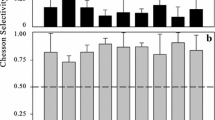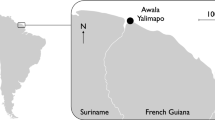Summary
The abilities of some zooplankton (rotifers, cladocerans, copepods) to ingest different sizes and kinds of food cells were quantified by determining the relative efficiencies with which they ingested nine tracer-cell types, ranging from a coccoid bacterium (0.45 μm3) to the alga Cryptomonas erosa (800–920 μm3). These efficiencies were obtained by dividing the clearance rate of each zooplankton group (species population, developmental stage or size class of a species population) on each 32P-labeled cell type by that of a simultaneously-offered, 33P-labeled, standard cell type — Chlamydomonas reinhardtii. Similarities of efficiency patterns on these cell types (food niches) between all possible pairs of the 17 zooplankton groups from 4 ecosystems were determined by calculating correlation coefficients. Although the utilization of the tested cell types may vary greatly within a species, three feeding guilds could be distinguished — based primarily on the efficiencies with which the smallest cell types were ingested. Guild I (Poyarthra vulgaris, Keratella crassa, Diaptomus minutus nauplii) ate the smallest cells (<4 μm diameter) (bacterium, Synechococcus, Nannochloris) and Ankistrodesmus very ineffifently but the three Cryptomonas species very efficiently. Guild II (Bosmina longirostris, D. minutus copepodites and Adults) had higher efficiencies on Synechococcus, Nannochloris, Ankistrodesmus, Stichococcus, and Stephanodiscus than guild I but similarly low ones on the bacterium and high ones on the Cryptomonas species. Guild III (Conochilus inicornis, Keratella cochlearis, Ceriodaphnia quadrangula, Diaphanosoma leuchtembergianum) differed from guilds I and II in having uniformly high efficiencies on all the small cells as well ad the larger ones. Principal component analysis of the matrix of correlation coefficients provided objective confirmation of the three guilds and provided a visual representation of the food niches of the 17 zooplankton groups in 3-dimensional space.
Similar content being viewed by others
References
Allen TFH, Koonce JF (1973) Multivariate approaches to algal strategems and tactics in system analysis of phytoplankton. Ecology 54:1234–1246
Bleiwas AH, Stokes PM (1985) Collection of large and small food particles by Bosmina. Limnol Oceanogr 30:1090–1092
Bogdan KG, Gilbert JJ (1982) Seasonal patterns of feeding by natural populations of Keratella, Polyarthra, and Bosmina: clearance rates, selectivities, and contributions to community grazing. Limnol Oceanogr 27:918–934
Bogdan KG, Gilbert JJ (1984) Body size and food size in freshwater zooplankton. Proc Natl Acad Sci USA 81:6427–6431
Bogdan KG, Gilbert JJ, Starkweather PL (1980) In situ clearance rates of planktonic rotifers. Hydrobiologia 73:73–77
Comita GW, Tommerdahl DM (1960) The postembryonic developmental instars of Diaptomus siciloides Lilljeborg. J Morph 107:297–356
DeMott WR (1986) The role of taste in food selection by freshwater zooplankton. Oecologia (Berlin) 69:334–340
DeMott WR, Kerfoot WC (1982) Competition among cladocerans: nature of the interaction between Bosmina and Daphnia. Ecology 63:1949–1966
Frane J, Jennrich R, Sampson P (1981) P4M — factor analysis. In: Dixon WJ, Brown MB, Engelman L, Frane JW, Hill MA, Jennrich RI, Toporek JD (eds) BMDP statistical software 1981. University of California Press, Berkeley, pp 480–499
Gilbert JJ, Bogdan KG (1981) Selectivity of Polyarthra and Keratella for flagellate and aflagellate cells. Verh Internat Verein Limnol 21:1515–1521
Gilbert JJ, Bogdan KG (1984) Rotifer grazing: in situ studies on selectivity and rates. In: Meyers DG, Strickler JR (eds) Trophic interactions within aquatic ecosystems. American Association for the Advancement of Science, Selected Symposium 85, pp 97–133
Holtby LH, Knoechel R (1981) Zooplankton filtering rates: error due to loss of radioisotopic label in chemically preserved samples. Limnol Oceanogr 26:774–780
Knisely K, Geller W (1986) Selective feeding of four zooplankton species on natural lake phytoplankton. Oecologia (Berlin) 69:86–94
Miracle MR (1974) Niche structure in freshwater zooplankton: a principal components approach. Ecology 55:1306–1316
Porter KG (1973) Selective grazing and differential digestion of algae by zooplankton. Nature 244:179–180
Sokal RR, Rohlf FJ (1969) Biometry. Freeman, San Francisco, pp 776
Starkweather PL, Gilbert JJ, Frost TM (1979) Bacterial feeding by the rotifer Brachionus calyciflorus: clearance and ingestion rates, behavior and population dynamics. Oecologia (Berlin) 44:26–30
Vanderploeg HA, Pfaffenhöfer G-A (1985) Modes of algal capture by the freshwater copepod Diaptomus sicilis and their relation to food-size selection. Limnol Oceanogr 30:871–885
Author information
Authors and Affiliations
Rights and permissions
About this article
Cite this article
Bogdan, K.G., Gilbert, J.J. Quantitative comparison of food niches in some freshwater zooplankton. Oecologia 72, 331–340 (1987). https://doi.org/10.1007/BF00377560
Received:
Issue Date:
DOI: https://doi.org/10.1007/BF00377560




